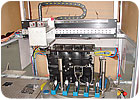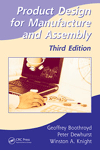
During production, each engine subassembly moves at high speeds on a conveyor belt past the iNspect cameras. Photo courtesy Teledyne Dalsa
Suppliers to the automotive market, like Cummins China, also use vision inspection systems. Cummins China is a supplier to the Chinese automotive market and part of the Cummins group that designs, manufactures, distributes, and services engines and related technologies.
For many years, Cummins China had used a vision inspection system to ensure that bushings on engine subassemblies were assembled correctly. The system performed as required, but engineers at Cummins China were unhappy with the vision supplier’s service and high maintenance costs.
As a result, in late 2008 the supplier replaced its current vision system with the iNspect system from Teledyne Dalsa. The iNspect system consists of TM2 cameras and a software suite with tools that perform inspection tasks such as positioning, measuring, identification, verification and flaw detection. System setup was easy, allowing Cummins China workers to quickly configure and deploy an application without any programming experience or extensive training.
Each engine subassembly contains two rows of five bushings, four of which are the same. Because the two rows of bushings are on different focal planes, two cameras are required for each inspection.
During production, each subassembly moves at high speeds on a conveyor belt past the iNspect cameras. An 8-millimeter CCTV lens and two ring lights on the cameras capture images of the subassembly and send them to a computer.
Three tools within the software then instantaneously compare the images to determine whether or not a subassembly is correctly assembled. The Auto Location Tool locates the bushings, the Count Tool verifies whether the bushings are reversed or positioned correctly, and the Match Tool determines whether the right bushings have been assembled.
Because iNspect is so intuitive, some operators have quickly become expert at programming and using the vision software, says Lake Zhang of Shanghai Botrong Electric Co. Ltd., the distributor that worked with Cummins China to install the iNspect system.
“Now they can develop any solution or tweak any parameters the way they want, which has resulted in significant maintenance time and cost savings,” says Zhang. “They are using machine vision throughout their production facility, and will continue to find ways to save inspection costs while maintaining production standards.”
Zhang also estimates that the iNspect system has saved Cummins China at least one worker’s yearly salary.
For more information on vision inspection systems, call 978-670-2000 or visit www.teledynedalsa.com.



